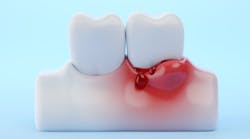Is rapamycin the next big breakthrough in periodontitis and oral cancer treatment?
Listen to the article on our podcast!
Rapamycin, also known as sirolimus, is a fascinating drug with a history as intriguing as its potential applications. Initially discovered in the soil of Easter Island, or Rapa Nui, rapamycin was originally prized for its antifungal properties.1 However, its influence extends far beyond that, impacting everything from organ transplantation to the latest antiaging research. Recent studies have begun exploring its potential benefits for oral health, which could open new avenues for dental medicine.
What sets rapamycin apart
What sets rapamycin apart from other compounds is its ability to inhibit a specific protein known as mTOR (mammalian target of rapamycin or mechanistic target of rapamycin). The mTOR signaling is crucial in regulating cell growth, proliferation, metabolism, and autophagy—the body’s process of cleaning out damaged cells and regenerating new, healthier ones. Rapamycin’s ability to inhibit mTOR made it a valuable immunosuppressant, especially in organ transplantation, preventing the body from rejecting new organs.
Rapamycin was first approved in the late 1990s at high doses to suppress the immune system. The inhibition of mTOR also plays a critical role in extending the lifespan of various organisms, which has led to rapamycin being studied as a potential antiaging drug. Although technically not approved as an antiaging drug, some physicians prescribe it off-label with the aim of fending off age-related conditions. Animal studies have shown that rapamycin can increase lifespan by 25%-60% in most species it’s been tested on.2 This has led to increased interest in use in humans, with ongoing clinical trials investigating its effects on conditions such as cardiovascular disease, neurodegenerative diseases, and cancer.3 Beyond aging, it has been shown to have anticancer properties, particularly in tumors that are dependent on mTOR signaling for growth.4 Its immunosuppressive capabilities are also being harnessed in treating autoimmune diseases, where the immune system mistakenly attacks the body’s own tissues.5
Applications for oral health
The mTOR pathway is important for managing inflammation and cellular regeneration, which shows promise for oral health. Disruptions in the mouth’s delicate balance of microbial flora can lead to conditions such as periodontitis, decay, and oral cancers. Rapamycin could possibly help mitigate these conditions, making it an area of growing interest for dental research.
Inflammation has a central role in the progression of periodontitis. Since the mTOR path is heavily involved in inflammatory processes, by inhibiting mTOR, rapamycin could potentially reduce inflammation in the gums and slow or even halt the progression of periodontitis. Animal studies have shown promising results, where rapamycin treatment reduced inflammation and bone loss associated with periodontitis.6 While human studies are still in the early stages, these findings suggest that rapamycin could become a valuable tool chiefly in severe cases that are resistant to conventional treatments.
Dr. Jonathan An, from the University of Washington School of Dentistry, was granted FDA approval to test rapamycin in patients with periodontitis. According to An, there has been some evidence from transplant patients that rapamycin may help improve oral health. An’s new study will measure changes in the participants’ microbiomes and their biological clocks. A previous study reported the use of rapamycin as an antiaging drug to treat elderly mice with periodontitis.7 Rapamycin improved the periodontal health after a short-term treatment. The study demonstrated that rapamycin could regenerate periodontal bone, attenuate gingival and periodontal bone destruction, and shift the oral microbiome to a more youthful composition.
Rapamycin and oxidative stress
I've spent much of my career promoting understanding of the oxidative stress and tissue destruction caused by periodontal disease, so I was intrigued to read that rapamycin could prevent bone loss by suppressing oxidative stress. This finding not only reinforces the role of oxidative stress in periodontal pathology but also suggests a potential therapeutic avenue for mitigating bone loss and promoting tissue regeneration in periodontal disease.8
Rapamycin is primarily known for its role in inhibiting the course of mTOR, which can influence various cellular processes, including oxidative stress. However, the effects of rapamycin on oxidative stress are context dependent. In many cases, rapamycin has been shown to reduce oxidative stress by promoting autophagy, enhancing mitochondrial function, and reducing inflammation, which can lead to decreased production of reactive oxygen species (ROS). This reduction in oxidative stress is part of the reason why rapamycin has been studied for its potential antiaging and tissue-protective effects. In some specific contexts, where rapamycin affects metabolic pathways differently, it might lead to an increase in oxidative stress, but generally, for aging and tissue preservation, rapamycin is associated with inhibiting oxidative stress.
The mTOR pathway is essential for cell growth and repair, and by targeting this pathway, rapamycin could promote the regeneration of oral tissues following surgery or injury. This has significant potential for patients undergoing dental procedures, such as tooth extractions or implants, where rapid and effective healing is vital. A careful consideration would be the dosage of rapamycin, as high doses have been shown to interrupt the wound healing process.
Oral cancer applications
Oral cancer is another area where rapamycin shows promise. Oral squamous cell carcinoma (OSCC), the most common type of oral cancer, is often associated with poor prognosis due to late diagnosis and aggressive progression. The mTOR pathway is frequently activated in OSCC, contributing to tumor growth and survival. Preclinical studies have indicated that, by inhibiting mTOR, rapamycin can reduce the growth of oral cancer cells and enhance the effects of other anticancer therapies.9 Although more research is needed to confirm these effects in humans, the initial results are encouraging and suggest that rapamycin could be incorporated into treatment protocols for oral cancer in the future.
Rapamycin is a drug with a broad range of potential applications, extending far beyond its original use as an immunosuppressant. Its ability to inhibit mTOR direction opens possibilities for treating age-related conditions, cancers, autoimmune diseases, and even oral health issues. While research is still in its early stages, the potential for rapamycin to revolutionize oral health care is immense. As studies continue to explore its effects on conditions such as periodontitis, oral cancer, and tissue regeneration, rapamycin may soon become a staple in the arsenal of treatments available to dental professionals, offering new hope for patients suffering from these challenging conditions.
I would like to thank Dr. Jonathan An for giving insight and review of this article.
Editor's note: This article appeared in the November/December 2024 print edition of RDH magazine. Dental hygienists in North America are eligible for a complimentary print subscription. Sign up here.
References
- Samanta D. Surendra Nath Sehgal: a pioneer in rapamycin discovery. Indian J Cancer. 2017;54(4):697-698. doi:10.4103/ijc.IJC_84_18
- Selvarani R, Mohammed S, Richardson A. Effect of rapamycin on aging and age-related diseases–past and future. Geroscience. 2021;43(3):1135-1158. doi:10.1007/s11357-020-00274-1
- Li J, Kim SG, Blenis J. Rapamycin: one drug, many effects. Cell Metab. 2014;19(3):373-379. doi:10.1016/j.cmet.2014.01.001
- Zou Z, Tao T, Li H, et al. mTOR signaling pathway and mTOR inhibitors in cancer: progress and challenges. Cell Biosci. 2020;10:31. doi:10.1186/s13578-020-00396-1
- Jing F, Yang F, Cui F, et al. Rapamycin alleviates inflammation and muscle weakness, while altering the Treg/Th17 balance in a rat model of myasthenia gravis. Biosci Rep. 2017;37(4):BSR20170767. doi:10.1042/BSR20170767
- An JY, Quarles EK, Mekvanich S, et al. Rapamycin treatment attenuates age-associated periodontitis in mice. Geroscience. 2017;39(4):457-463. doi:10.1007/s11357-017-9994-6
- An JY, Kerns KA, Ouellette A, et al. Rapamycin rejuvenates oral health in aging mice. Elife. 2020;9:e54318. doi:10.7554/eLife.54318
- Feng C, Liu Y, Zhang B-Y, et al. Rapamycin inhibits osteoclastogenesis and prevents LPS-induced alveolar bone loss by oxidative stress suppression. ACS Omega. 2023;8(23):20739-20754. doi:10.1021/acsomega.3c01289 [Erratum in ACS Omega. 2023;8(44):42005. doi:10.1021/acsomega.3c07440]
- Semlali A, Papadakos S, Contant C, et al. Rapamycin inhibits oral cancer cell growth by promoting oxidative stress and suppressing ERK1/2, NF-κB and beta-catenin pathways. Front Oncol. 2022;12:873447. doi:10.3389/fonc.2022.873447
About the Author

Anne O. Rice, BS, RDH, CDP, FAAOSH
Anne O. Rice, BS, RDH, CDP, FAAOSH, founded Oral Systemic Seminars after over 35 years of clinical practice and is passionate about educating the community on modifiable risk factors for dementia and their relationship to dentistry. She is a certified dementia practitioner, a longevity specialist, a fellow with AAOSH, and has consulted for Weill Cornell Alzheimer’s Prevention Clinic, FAU, and Atria Institute. Reach out to Anne at anneorice.com.


